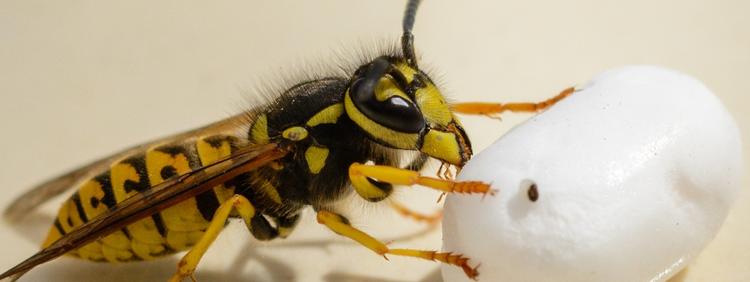Guelph Pest Control: What Are Social Wasps?

In the insect world, there are two basic types of wasps: solitary wasps and social wasps. The vast majority of wasp species are solitary, meaning that they make individual nests and raise offspring on their own. A minority of wasp species are social, meaning that they live together in large colonies. Though there are fewer types of social wasps, they are more likely to require wasp pest control services in Guelph because of conflicts with humans.
What Makes Wasps Social?
Solitary wasps make individual nests, but that does not mean that they live completely isolated from one another. Different wasps of the same species may make nests in close proximity to one another, but that does not make them social wasps.
The main difference between social wasps and solitary wasps is that not only do social wasps all live together in the same nest, but each individual has a specific role to play within the colony. Some exist for reproduction, while others care for offspring. Some go out to find food, while others stay behind to build and maintain the nest. It is this division of labour among the members of each colony that make these wasp species truly social.
What Are Some Specific Types of Social Wasps?
The most familiar types of social wasps are paper wasps, hornets, and yellowjackets.
All of these wasp species chew up wood and mix it with their saliva to produce a paper-like material that they use to make their nests. Paper wasps’ nests are unique because there is no external covering. The nests consist of only one tier of cells, which forms roughly an umbrella shape that hangs from the underside of an eave from a short stalk. Up to 100 paper wasps live together in a single nest at a time.
Hornets live in colonies of a few hundred individuals. Their bodies are primarily dark in colour and about an inch long. The abdomen, thorax, and face have lighter spots in shades of white, cream, or light yellow. Hornets typically build nests that hang from tree branches but may also attach them to house siding, shrubbery, or utility poles. Unlike paper wasp nests, hornets’ nests have an outside covering with a single hole at the bottom for the wasps to get in and out. Inside the nests are numerous cells in many tiers.
Yellowjackets live in the largest colonies of social wasps that can consist of up to 5,000 members. They are more likely to build nests underground or inside a wall void or hollow log. While the nests are often hidden, the yellowjackets may be observed flying in and out of the opening. Yellowjackets can be up to three-quarters of an inch long, approximately the size of a honeybee, with smooth, tapered bodies and alternating black and bright yellow stripes. When foraging for food, most yellowjackets remain within a few hundred yards of the nest.
What Makes Social Wasps More Dangerous Than Solitary Wasps?
Social wasps are more aggressive than solitary wasps. This is not to say that social wasps actively look for opportunities to sting you, but they are more likely to sting if they feel their nest is threatened. A single wasp can sting you more than once, and once a wasp stings, it releases a pheromone that prompts other colony members to attack as well. If you get too close to a nest of social wasps, you may find yourself on the receiving end of many stings from multiple wasps, a painful and potentially dangerous situation.
Call Truly Nolen for Wasp Pest Control Services in Guelph
The process starts by identifying the insect and determining whether removal is necessary and which control method to use. Find out more about why professional wasp removal is preferable to attempting to do it yourself.